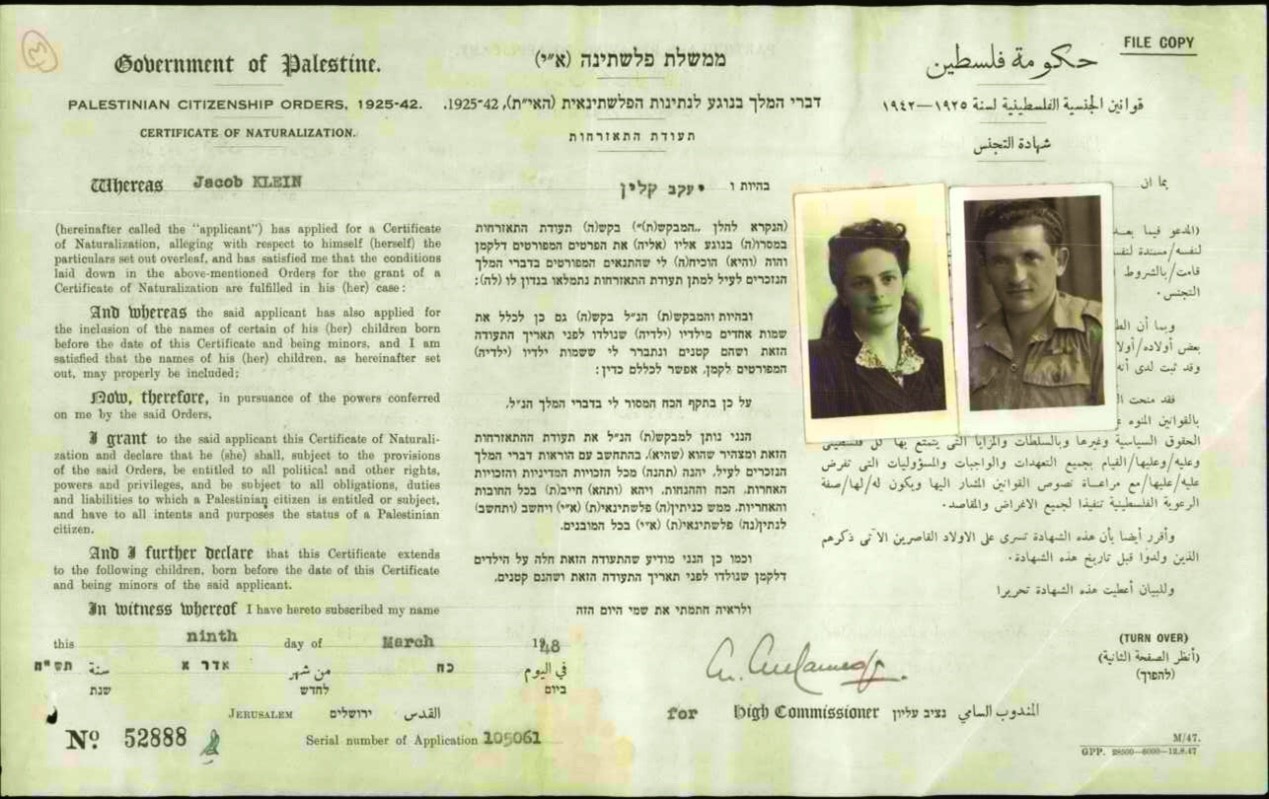Home>The Rose Family in World War Two - The Battle Front >The Three Musketeers
The Three Musketeers
“The three musketeers” is the name given by Jenny Grossman’s youngest son, Norman, to three friends, European Jews who had immigrated to Palestine before WWII and who married two sisters and a cousin from the same family.
Edna Jacobs, the eldest daughter of Dora Jacobs, was the first to marry on October 1. 1945, followed by Freda and Minnie Grossman in a double wedding on 14 October 1945.
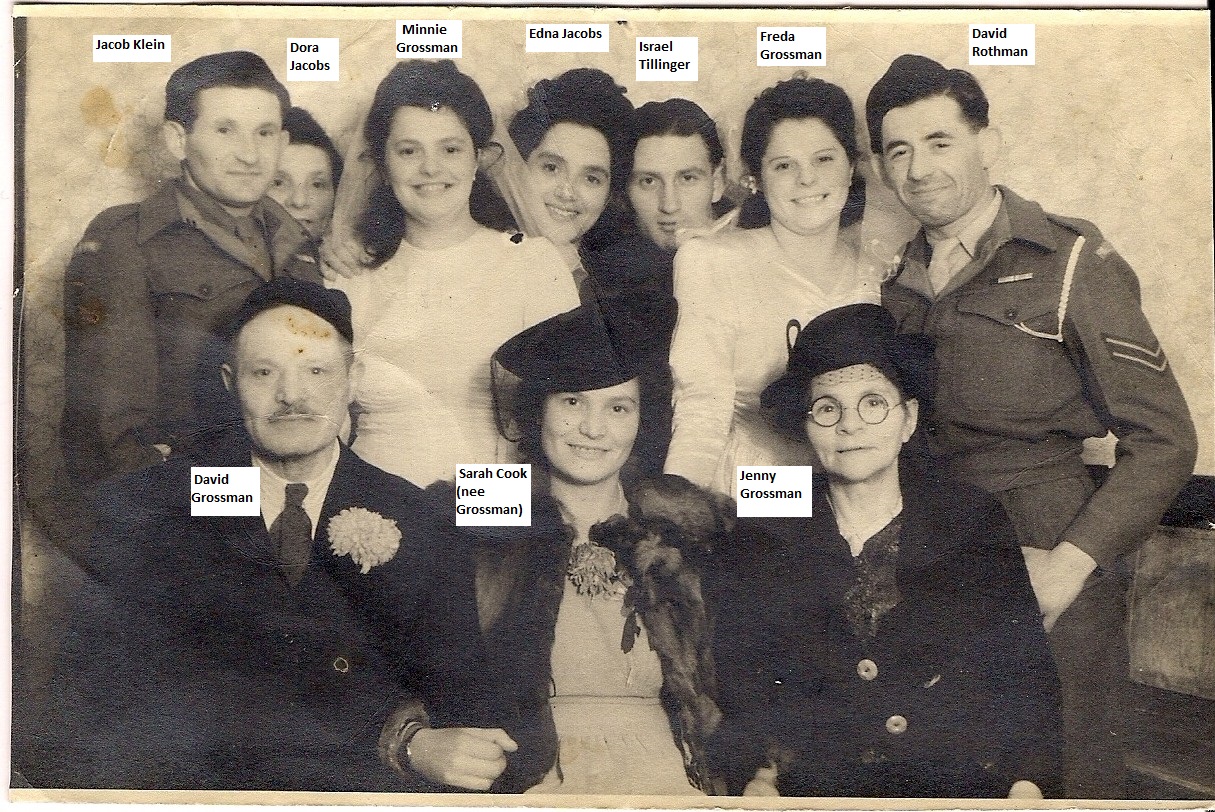 1945 Double Wedding of Minnie and Freda Grossman to Jacob Klein and David Rothman
1945 Double Wedding of Minnie and Freda Grossman to Jacob Klein and David Rothman
Edna Jacobs and Israel Tillinger centre back
Edna Jacobs married Israel Tillinger, originally from Rumania, Freda Grossman married David Rothman, born 19 January 1917 in Uzhhorod, Zakarpattia Oblast, Ukraine, and Minnie Grossman married Jacob Klein, born in Mukacevo, Czechoslovakia, on 15 October 1918.
It appears that all three had joined the British Pioneer Corps in Palestine, although we only have documentary proof that Jacob did so.
What's on this page ..
- The Musketeers from the point of view of David Rothman
- The Musketeers from the point of view of Jacob Klein
- The Musketeers from the point of view of Israel Tillinger

The Musketeers from the point of view of David Rothman
View David Rothman's profile (opens in new window).
David entered Palestine illegally in 1940 on a ship that docked at Haifa. He was arrested on 8 January 1940 and confined to the Atlit Detention Camp. An application for his deportation was drawn up on 21 January 1940.
Although his name appears on an undated list described by the Israel Genealogical Research Association as "Return of Illegal Immigrants who had been deported from Palestine", it is possible that he was never deported at all because wartime Britain lacked the ships to carry out the deportations. His name also appears in a Book of Army Volunteers 1939-1945. We know from his memoirs that David participated in the battle of Crete which was waged between 20-28 May 1941. It is likely, therefore, that, rather than deporting him, the British authorities welcomed him into the ranks of the British Pioneer Corps.
According to Freda and David Rothman’s daughter, after reaching Palestine her father joined a Jewish paramilitary organisation such as the Haganah (Defence) or the Irgun (Organisation) that operated in Mandate Palestine up till 1948, when they were incorporated into the Israel Defence Army.
On 1 August 1940 Jacob Klein enlisted in Company 606 of the British Pioneer Corps, the only British military unit that accepted aliens. Jacob completed his basic training at Sarafand (present-day Tzrifin in central Israel), site of the largest British military base in the Middle East in the 1930s and 1940s.
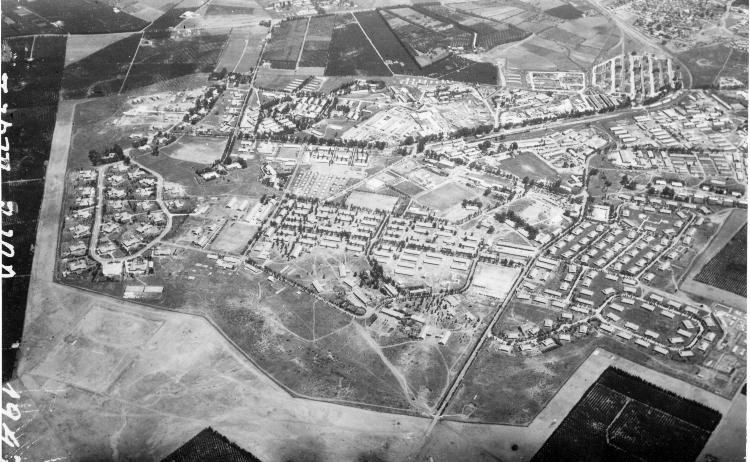 Sarafand
SarafandOn 28 November 1940, Company 606 was transported to Egypt to carry out engineering works on the Egyptian-Libyan border, amongst other duties.
On 8 March 1941, the company sailed to Greece, which was attacked by the Germans on 6 April 1941, and where the company was put to work keeping the port open. The evacuation of the British Expeditionary Force from Greece to Crete commenced on 21 April 1941.
The battle of Crete was waged between 20-28 May 1941, resulting in the defeat of the allied forces. Between 28 May and 1 June allied troops were evacuated to Egypt. Unfortunately David Rothman was one of those injured and captured by the Germans, while Abe Grossman’s brother-in-law, Philip Cohen, who served as a sailor, was killed in the naval battle.
David Rothman:
At Crete I have been in a provisional Hospital. Knocked about while I have been captured at Crete 1941 by paratroops, forced me to march from one end the Island at Crete almost to the other end of it without drinks and food. Just before captured I have been wounded on my left ankle and become an invalid, and in such a state they forced me to march with swollen and fractured legs.
Throughout the whole of June the Palestinians remained in a German POW camp in Crete in terrible conditions. Finally at the beginning of July 1941 they were transported by ship to Salonika in Greece.
David describes the conditions aboard ship:
After I arrived in a camp at Crete we had to wait for embarkation to Saloniky Greece where we had to wait for a large transport. We have been transported as an animal at the bottom of the ship, without air, food and drink.
At Salonika things were no better:
After arriving at Saloniky a few of us has been shot at and killed by the Germans.
The Palestinians were among the first to be sent in sealed cattle cars to Germany:
From there they have taken us by train in animal wagons 60-80 prisoners in one wagon without any sanitary conditions.
Their journey ended on the Yugoslav-Austrian border on 3 July 1941, where they were divided between two temporary camps, Wolfsberg and Marburg:
We arrived at Austria in a camp called Wolfsberg Italy No XVIII.A. where I got a prisoner number 5355. For a time I had to go out to work on different jobs.
It was at this camp that the Jews were segregated from the other prisoners.
At the end of July 1941 David and his 1,160 fellow Palestinians were transferred to a permanent camp at Lamsdorf or Łambinowice in Silesia, Poland:
From there I have been moved to Oberschlesien into a camp called Stalag VIII Lamsdorf. At the camp I had to work different jobs.
The Lamsdorf camp was a large base camp. It is estimated that 100,000 Allied POWs passed though it during the war years.
Whilst at Lamsdorf, in 1942 David was sent with a working party to the Polish town of Krappitz or Krapkowice, a centre of light industry.
From there I have been send to a town or farm in a big paper factory called Krapin. There they have forced me to work the hardest work to unload wood from train, coal from trains glaber salt, celluloid and the hardest work & transport I had to carry heavy machineries on my shoulders and back, where I couldn’t stand it anymore.
It was here that he decided to stand up for his rights as a non-commissioned officer (he was a corporal) which, according to the Geneva Convention, excluded NCOs from having to work.
After 8 months hard work I found out that N.C.O’s hasn’t got to work according to the General Convention of the Red Cross. But they still forced me to work, so I have decided to refuse to work anymore there and have asked for a transfer back to the Stalag and have also asked for a Red X member Mr. Berg from Sweden and a German General should be present by questioning me for my refusal to work for the Nazis.
His protest came at great personal cost.
They wouldn’t listen me anymore. In the morning they put me to the wall with hands up with two other prisoners just like a sentenced of death with all the regulations, and tried to frighten me. I of course refused to return to work so they have put me in a dark cellar. In another cellar without light at all without any air, 1 meter the size of cellar was, 1 meter 70 cm of wide very cold and wet. I had no place even where to sit down. I have been kept all over night there no blankets at all, no food no drinks. I shivered and have almost died from fever and cold & hunger.
At the middle of the night the Unter Oficer Feldvebel and 2 of the managers of the factory, one of them a big Nazi folks Deutsch whose name was Gargon, came in. I couldn’t see them almost after the darkness of about 24 hours. They had a torch in hands guns and sticks & pistol. They asked me if I am willing to go back to work. I refused. They have beaten me out with gun and kicked me out almost all my teeth, kicked me in my stomach and head, and all over where they could find me. Only they wanted to fire on me and kill me, but as I remember one of them said they shouldn’t kill me because our Camp leader’s prisoners already knew about it. So they were afraid to do it of their own accord. They left me alone until the morning and gave me some small slice of bread and water. I couldn’t then have it anymore. Since then I am suffering stomach and other troubles.
The result of his protest came the next morning when he was taken to Opole or Oppeln, also in Silesia, Poland, and put to work.
Next morning I have been taken out from the cellar and taken away to a prison in a town called “Opelm” There I had to work near the station on unloading iron and coal from wagons. I worked a time there.
After this David returned to the Lamsdorf main camp,
One day my guard came in to my cellar early in the morning, and told me that he is taking me away to another prison, but on the road he changed his mind and told me that I am going back to STALAG VIII Lamsdorf.
where he was imprisoned instead of being able to move about freely.
At Lamsdorf I have been put into prison in camp, where I have been kept for a time.
In August 1942 a British POW camp was set up at Latrun in Palestine. Its German inmates complained of ill-treatment by their British captors. In retaliation the Germans set up a penal camp at Chelm or Cholm near Lublin in Poland, to which David and another seventy four Palestinian non-commissioned officers were transferred, together with a similar number of British prisoners:
From there they have taken me to a reprisal camp at Poland into a town called “Edelm” where I have been kept with 75 Palestinians and 75 Allied Forces, under strict control. The Germans sadists wouldn’t allow us to put on shoes nor great coats. We had to walk around in wooden “clogs” and were forced to go out for hours to the compound in the biggest snow and cold for Apel, called English Rolco (roll call).
The Red Cross brokered an agreement between the two sides according to which both camps were shut down. When the Cholm camp closed down at the end of May 1943 David and his fellow Palestinians returned to the Lamsdorf base camp for a short time:
After 8 months being there they send us back to STALAG VIII.B. Lamsdorf.
Some of the Lamsdorf POWs helped to build a concentration camp at Jaworzno, which opened on 15 Jun 1943. This camp provided forced labour for the Jaworzno coal mines, in which the Palestinian POWs also worked. They would pass Auschwitz on their way to work. Towards the end of their time in the mines, they met up with a group of Jewish prisoners from Auschwitz, to whom they managed to smuggle food and with whom they even exchanged information.
The last camp in which David was imprisoned was at Hohenfels, a POW camp in Bavaria, Austria.
Being there a short time, we have been shifted again to Bayern a place called Hohenfels a large N.C.Os camp and been kept. At the camp I had to work in the forest cutting wood and to bring for the camp. At that camp we have been kept chained for months and punished.
We know for certain that he was at this camp from November 1943 to March 1944, because of the dating of some oil paintings that he executed during his stay there. In spite of David’s claim that he was forced to work, Hohenfels was considered a non-working camp and its inmates were free to pursue whatever interests they chose. This explains the existence of David’s paintings.
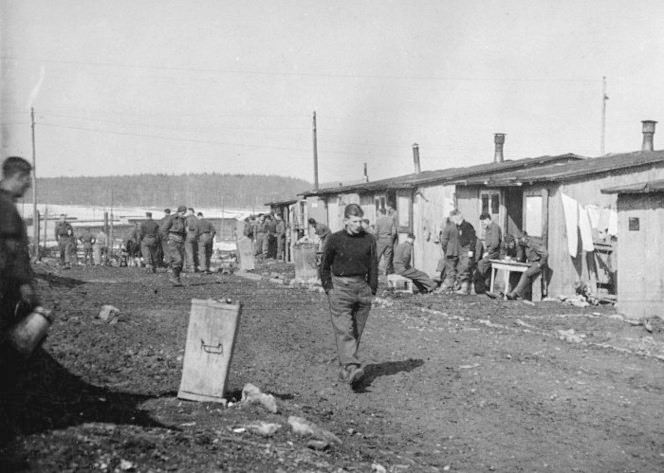 Hohenfels POW Camp
Hohenfels POW Camp
Shows New Zealand Troops
The end of the war was fast approaching but not the end of David’s suffering.
From that camp the Germans forced us to march for a few weeks to the other end of Germany without food and drink, and slept outside at the snow, bitten (beating) us on the road for not being able to march. I have been very sick. They wouldn’t give me any medical treatment. After a time we have been liberated by the Americans.
The march, in which David and his fellow Palestinians were forced to participate, was one of a series of forced marches that took place over a four-month period, from January to April 1945, in freezing conditions. Almost a third of the 257,000 Allied POWS imprisoned in Europe were forced to march westwards into the heart of Germany, to prevent their liberation by advancing Russian troops from the east. These marches were called by various names, one of which was 'The Long March'.
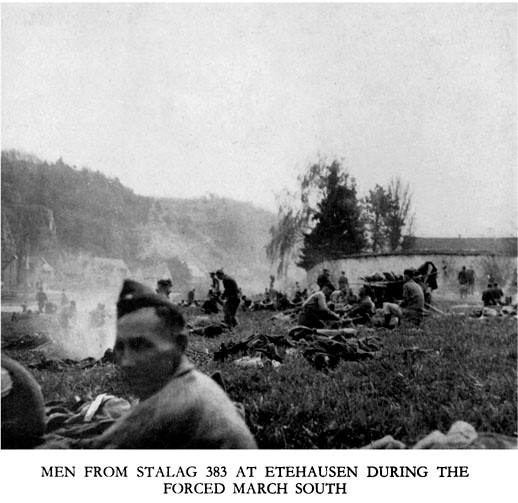
On 22 January 1945, when it seemed likely that the Russians would soon reach Hohenfels, the Germans started evacuating the inmates to a camp south of the town of Görlitz, in Lower Silesia. This camp was located 240 kilometers from Lamsdorf, a distance that took twelve days on foot. Four hundred out of the hundreds of Palestine POWs in the camp left with the third group. Another group of seventy left on 15 February.
On 10 February 1945 the POWs at Görlitz began to be evacuated further west. The evacuation lasted until May 1945.
During the period of 'The Long March' (January till April), the Palestinian prisoners were dispersed throughout Germany, Austria and Czechoslovakia. Some, like David, were marched from one end of Germany to the other, under the most horrific of conditions. Many did not survive. David was probably liberated by the American army near Regensburg.
The liberated Palestinians, like David Rothman, Jacob Klein and Israel Tillinger, were taken to the UK. Nine hundred of them were placed in a transfer camp at Newcastle. It is likely that the three men met up here.
At some point the three were in Birmingham where they met three young Jewish women from the same family. These were Freda and Minnie, daughters of Jenny Grossman, and Edna, daughter of Dora Jacobs. Edna and Israel were the first to marry, followed soon after by Freda and David, and Minnie and Jacob, in a double wedding that took place on 14 October 1945.
On 5 November 1945 David was returned to army service after liberation from captivity, and entered Palestine as a discharged member of His Majesty’s Forces who had been registered as an immigrant. By 30 December 1945 Jacob was also registered as a Palestinian immigrant.
David was discharged from service on 2 March 1946. Between 1945 and 1948 he served in the Palestine Police.
Jacob was discharged the same month as his friend, David, on 29 March 1946. His military conduct was described as “very good”. On 30 April 1946 a passport was issued at London to Jacob’s wife, Minnie, for the purpose of immigrating to Palestine. She was accompanied by Israel’s wife, her cousin, Edna. They travelled first by ship to Kantara in Egypt, an important hospital centre in World War II, where Minnie and perhaps also Edna registered as Palestinian immigrants on 15 May 1946. From there they continued on a train belonging to the Palestine Railways to Tel Aviv - Jaffa.
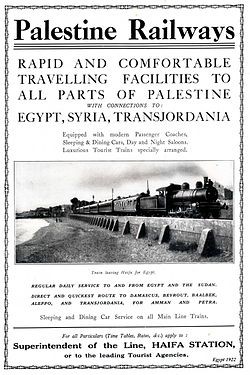
Because of difficulties with her papers, Minnie’s sister, Freda, was able to join them only later. Her husband, David, had been discharged from the army on 2 March 1946. At the time he was a lodger in the house of B. Gross at 151 Nahlat Benjamin Street, Tel-Aviv. Five days later, on 7 March 1946 he received approval for his wife to be repatriated to Palestine. Her move to Palestine was arranged by the War Office. It took another seven months for her to arrive. She too sailed from the UK to Egypt, where she was placed in the Ismailia Transit Camp. On 10 September 1946 she was issued with a movement order which was not to "be handed over or shown to any authorized person during the journey", ordering her to travel by train from the Ismailia Transit Camp to Tel Aviv.
Whereas Edna and Israel lived in Holon, the two Grossman sisters and their husbands shared a small apartment in Tel Aviv. Minnie and Jacob’s first child, a daughter named Hannah, was born 31 January 1947. Edna and Israel’s only son, Nisan (Hebrew) or Nissim (Yiddish), was also born in 1947, while Freda and David’s only daughter, Tova, was born on 21 July 1948.
In 1948 Edna was diagnosed with cancer. Her brother, Gerald Jacobs, who was a doctor, travelled out to Israel to bring her and her infant son back to the UK for treatment. The family paid for their tickets. Her husband, Israel, was unable to pay his passage and remained in Israel. Edna died in February 1950. Apparently her dying wish was that her son be looked after by her youngest uncle, Moishe Rose and his wife, Ellen Addlestone, who were childless.
In 1958 Freda and David Rothman immigrated to the States where David's brother, who had somehow survived the war, had settled. Minnie and Jacob remained in Israel, where their small apartment in Tel Aviv became the first port of call for almost every Rose family member who visited the country.
References
This account is based on a personal memoir by David Rothman written on 21 September 1954.
The wartime experiences of David Rothman have been placed in historical context by reference to the source mentioned below.
Yoav Gelber, "Palestinian POWs In German Captivity", Yad Vashem Studies, Vol. XIV, Yad Vashem, Jerusalem, 1981 pp. 89-137.

The Musketeers from the point of view of Jacob Klein
View Jacob Klein's profile (opens in new window).
Many people have written of their wartime experiences – experiences of such a traumatic nature that many never talked or wrote about them at all. Nine years after the end of WWII, on the 21st of September 1954, helped by his wife, Freda Grossman, David Rothman wrote a descriptive record of his harrowing experiences as a Palestinian prisoner-of-war in Europe. At an unknown date, his brother-in-law, Jacob Klein, did the same. However, instead of being descriptive, his record contains only dates and place names.
David Rothman's record is written in English, while Jacob Klein's is written in Hebrew. Since Modern Hebrew omits vowel signs, this has complicated the identification of the German, Czech and Polish names of the places through which Jacob passed. Another difficulty encountered is due to the return of territory after WWII. Some of the places formerly in German territory are today in Czech and Polish territory and their names have been changed accordingly.
What is immediately clear from both accounts is that the two men, who eventually became friends and brothers-in-law, were not in the same places at the same time. Therefore it is most likely that they only met up in the UK, to where they were sent for demobilization at the end of the war in 1945.
Jacob Klein's list of dates and place names divide into seven periods:
- From Czechoslovakia to Palestine
- From Palestine to North Africa
- From North Africa to Greece
- From Greece to Poland via Austria
- Lamsdorf POW Forced Labor Camps
- From Poland to Germany - The Long March
- From Germany to the UK - Liberation and Demobilisation
From Czechoslovakia to Palestine
The first period in Jacob Klein's record covers his departure, on 29 April 1939 at the age of 21, from his birthplace in Munkács (modern Mukacevo) in Czechoslovakia, and his arrival in Budapest, the capital of Hungary.
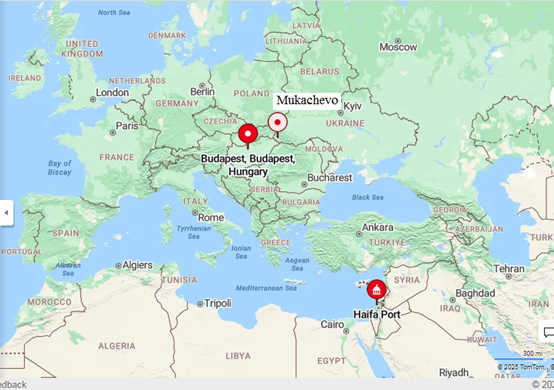
On the eve of the Holocaust, Munkács was the largest and most important Jewish community in Subcarpathian Rus', Czechoslovakia. The immediate cause of Jacob leaving Munkács seems to have been the fact that, in 1939, the Hungarians seized and annexed the whole region—including Munkács—taking advantage of the dismemberment of Czechoslovakia by its more powerful neighbors. During the 5-year war that followed, Hungary was an ally of the Axis powers, the major members of which were Germany, Italy and Japan.
The Haifa that greeted Jacob on his arrival was a mixed city of Arabs and Jews that functioned as the main British port in the eastern Mediterranean. Earlier that year, in March 1939, an unsuccessful 3-year Arab revolt had finally come to an end. The revolt had been against British rule, against a Jewish national home in Palestine and against Jewish immigration. Its failure left the minority Jewish population in a stronger position than before.
From Palestine to North Africa
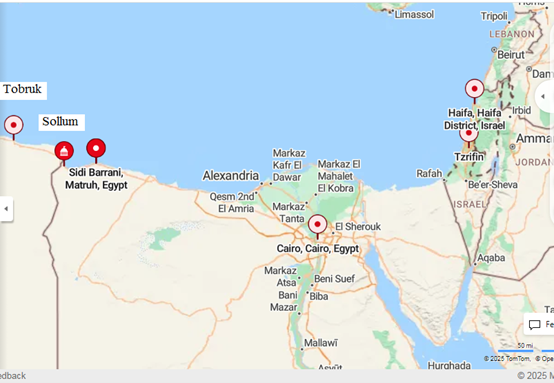
Jacob's first three months in Palestine are unaccounted for. After spending 9½ months at Sarafand (modern Zrifin), a British base founded in 1917 during WWI, on 7 August 1940 he left to join the Auxiliary Military Pioneer Corps (the AMPC). In the early part of WWII, the Pioneer Corps was the only British military unit in which enemy aliens could serve. After 3 months with the AMPC, on 7 November 1940 he was sent to Cairo in Egypt, over a year after reaching Palestine.
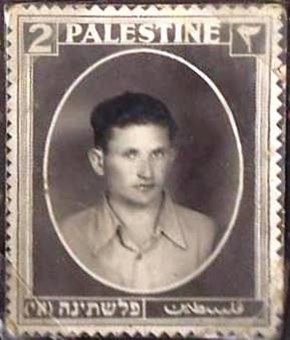
Jacob Klein 1940
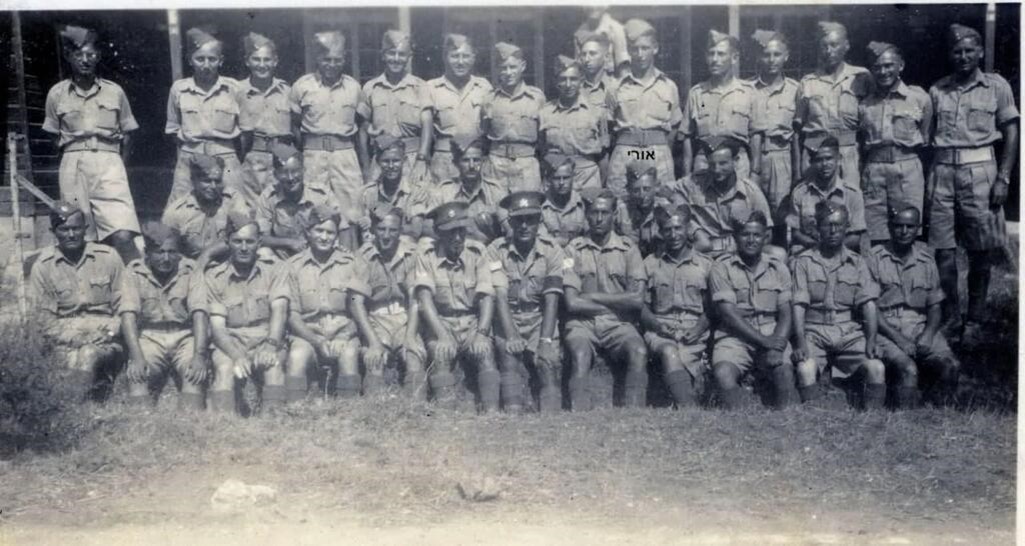
Jacob Klein front row, fourth from left
From North Africa to Greece
After reaching Cairo, the capital of Egypt, Jacob was in the area of Sidi Barrani, a port located on the shores of the Mediterranean, for the opening battle of Operation Compass, the first major British offensive in the Western Desert Campaign. The battle was fought between 10–11 December 1940 between Britain and its Imperial and Commonwealth allies and Germany with its Italian allies.
A month earlier, Sidi Barani had been occupied by the Italian Army during its invasion of Egypt. Now, a month later, the port was re-occupied by the British and its allies. As the Italians fled westwards, they were shelled from the sea in the area of Sallum, a small village west of Sidi Barrani, also mentioned in Jacob's record.
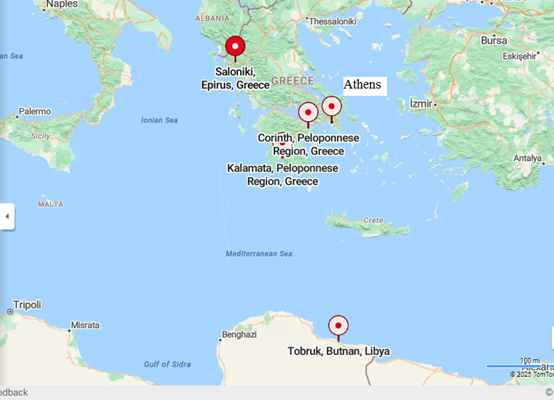
Following this battle, Jacob was sent 150 miles west to Tobruk in Libya, where Allied forces, mainly the Australian 6th Division, captured Tobruk on 22 January 1941.
Finally, after spending a total of about 4½ months in North Africa, he sailed to Greece on 21 March 1941.
From Greece to Poland via Austria
When Jacob reached Greece, it was to find the country fighting for its freedom against Italy and Germany. The Balkans campaign of World War II had begun with the Italian invasion of Greece on 28 October 1940. During the early months of 1941 Italy's offensive had stalled, enabling the Greek forces to conduct a counter-offensive in which they managed to occupy part of Albania. Unfortunately this success was short-lived.
While the Greeks were busy on their northwest border with Albania, Hitler decided to come to Italy's aid by invading Greece through Yugoslavia and Bulgaria, thus opening up a second front in the northeast of the country. Beginning on 6 April 1941, German forces crossed the border into mainland Greece, where they quickly moved south to overrun the rest of the country.
Meanwhile, the British had landed troops and aircraft to shore up the Greek defences. By 24 April 1941 more than 62,000 Empire troops (British, Australians, New Zealanders, Palestine Pioneer Corps, Cypriots etc.), had arrived in Greece, comprising the 6th Australian Division, the New Zealand 2nd Division and the British 1st Armoured Brigade.
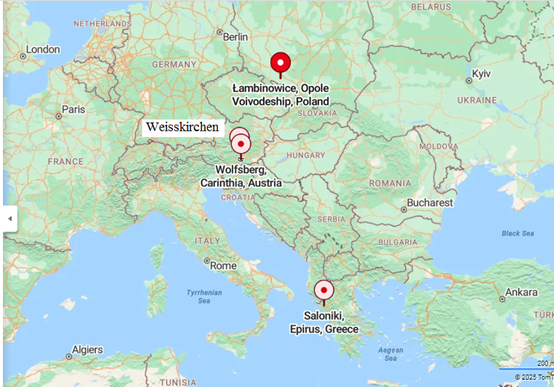
Jacob Klein was among them. On 22 April 1941 he was sent from Athens, the capital of Greece, to Kalamata, a small city on the southern coast of the Peloponnese peninsula in southern Greece. Kalamata's importance lay in the fact that it had a port from where Allied forces could be evacuated by ship.
The Battle of Kalamata took place on 29 April 1941, between the British and its allies and forces of the German 5th Panzer Division and some SS units. It was fought to keep the port open while 50,000 Allied troops were evacuated to escape capture by the enemy. 8,000 others were left behind and, as a result, were taken prisoner by the Germans. Among them were Jacob Klein and his fellow Palestinians.
By the following day, all of mainland Greece was under German or Italian control. Thus ended the Battle of Greece. Three weeks later, on 20 May 1941, Germany invaded Crete by air, and by 1 June all remaining Greek and British forces on the island had surrendered, Jacob Klein's future brother-in-law, David Rothman, was among them.
On 11 May 1941 Jacob was sent to a dulag or transit camp in Corinth, in south-central Greece.
A month later, on 13 June 1941, he was taken by train to Salonika, the second-largest city in Greece and the only Jewish-majority city in Europe at that time. The city had been heavily bombarded by the Italians. By November 1940 232 people were dead, 871 wounded and over 800 buildings damaged or destroyed. However, it did not fall to the Italians, but to the Germans on 8 April 1941. The Nazis forced the Jewish residents into a ghetto near the railroads and on 15 March 1943 began the deportation of the city's Jews to Auschwitz and Bergen-Belsen concentration camps. Most were immediately murdered in the gas chambers. Of the 45,000 Jews deported to Auschwitz, only 4% survived.
On 26 June1941 Jacob was taken by train from Salonika to Wolfsberg, Austria, the location of a large German base camp with about 7,000 inmates called STALAG XVIII-A, a journey that took 5 days. He spent a week at the base camp before continuing on to a work camp at Weisskirchen on 11 July 1941.
After two weeks, on 28 July 1941 he was returned to the base camp at Wolfsberg, before starting out on a 4-day train journey to Poland, where he spent much of the rest of his captivity in work camps connected with another large base camp called STALAG VIII-B, located near Lamsdorf (modern Łambinowice) in Silesia.
Lamsdorf POW Forced Labor Camps
From this time on, until the beginning of 1945, Jacob was imprisoned in a number of British prisoner-of-war forced labor camps, from among the more than 700 camps in the region administered from the Lamsdorf base camp.
The region of Silesia, which comprises Lower Silesia in the west and Upper Silesia in the east, lies today mostly in Poland, with small areas located in the Czech Republic and Germany. During WWII it was all under German control. Upper Silesia is rich in such natural resources as coal, lignite zinc, lead and iron, while Lower Silesia has large copper deposits. For this reason, although mainly rural, the region had also developed important industrial areas, of great strategic value to Germany's war effort.
Silesia was also the location of the extermination camps of Auschwitz (modern Oswiecim) and Gross-Rosen (modern Rogoźnica), both conveniently positioned near the largest reservoir of people earmarked for extermination under the Nazi regime - the 3 million Jews of Poland. This reservoir, together with the conquered peoples of the region and the enemy POWs, provided an endless supply of labor to extract the mineral wealth of Silesia out of the ground.
Silesia was liberated by the Red Army early in 1945. In order to save the industrial infrastructure of the region, a massive number of troops was employed to carry out the offensive, with a minimal use of heavy artillery and air-bombardment. Witnesses describe how countless Russian troops marched through the town of Tarnowitz (modern Tarnowskie Góry, mentioned by Jacob in his list of place-names), shoulder-to-shoulder in a matter of minutes, followed by almost complete silence.
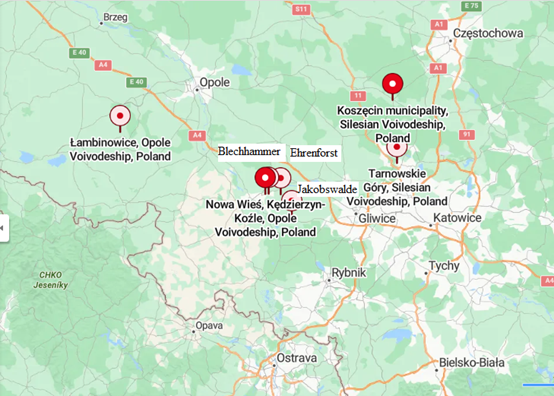
The Lamsdorf Work Camps
16 August 1941 to 19 January 1943
For 9½ months, from 16 August 1941 to 24 May 1942, Jacob worked in work camp number E207, located in Ehrensforst (modern Sławięcice).
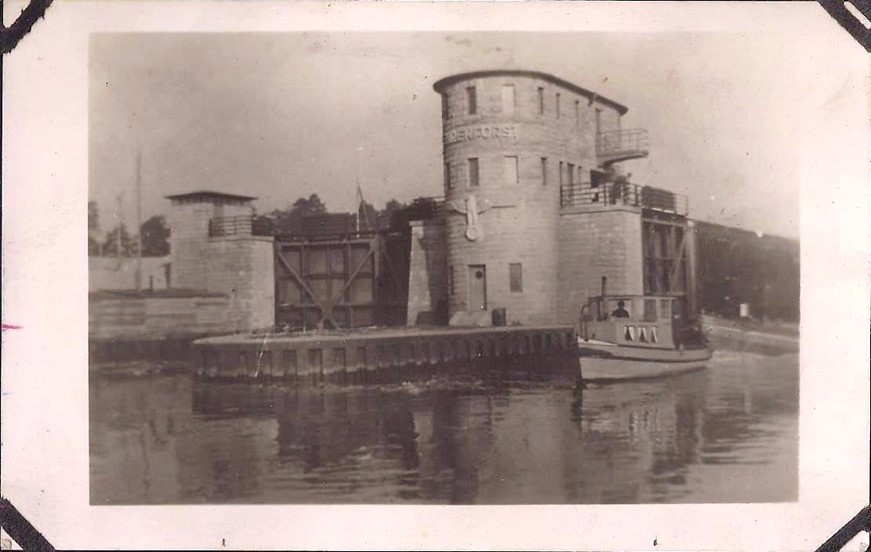
Ehrensforst
During this period he and his fellow-captives worked in the Blechhammer or 'sheet metal hammer' complex (modern Blachownia Śląska).
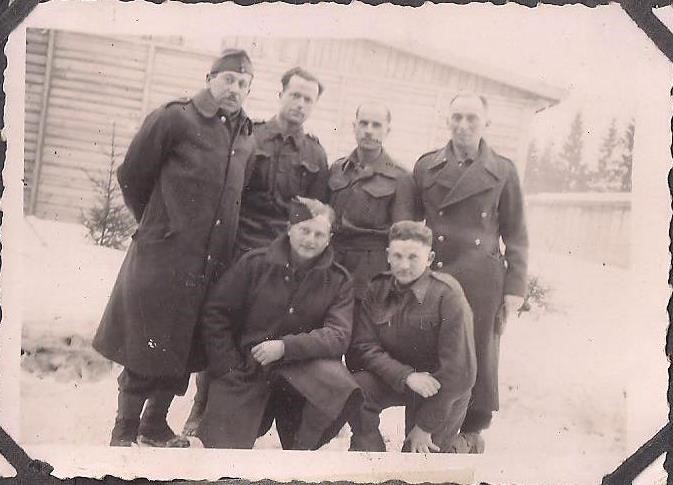 Jacob Klein (bottom right) in Ehrenforst
Jacob Klein (bottom right) in EhrenforstThis complex consisted of chemical plants, prisoner of war camps, and forced labor camps. However, it was not sheet metal that was manufactured at Blechhammer during WWII, but synthetic oil.
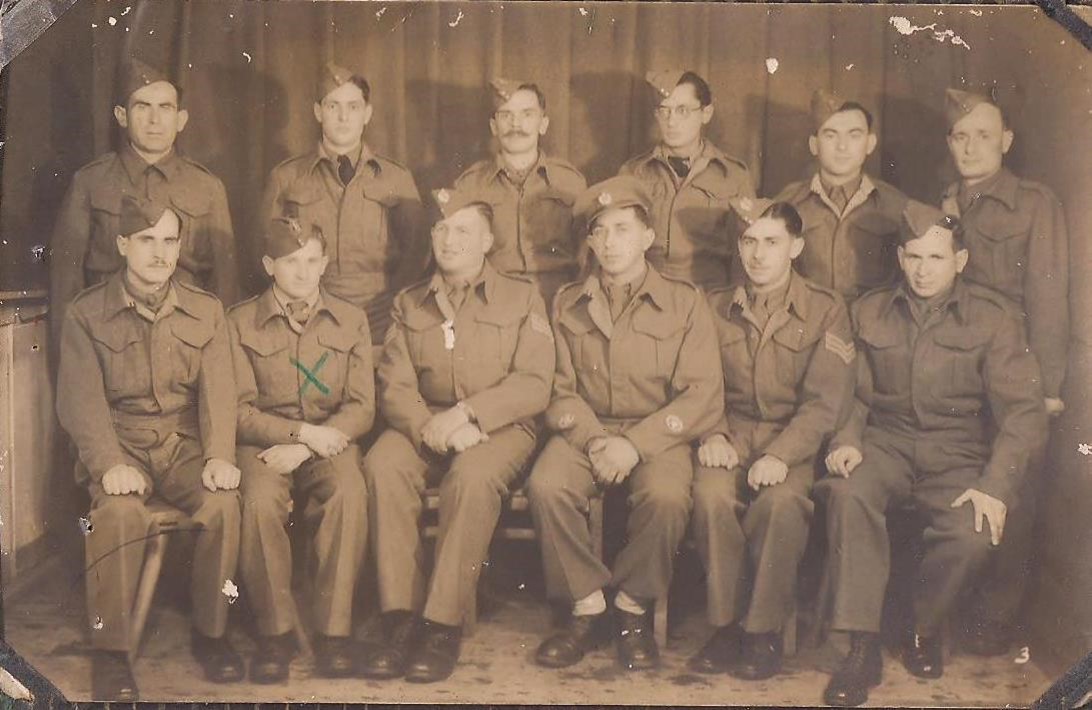 Jacob Klein bottom row second from left Neudorf
Jacob Klein bottom row second from left NeudorfOn 25 May 1942 Jacob and his fellow prisoners were marched on foot to their next work camp, number E427, at Neudorf (modern Nowa Wieś), where he spent another 6½ months, from 25 May 1942 to 6 December 1942.
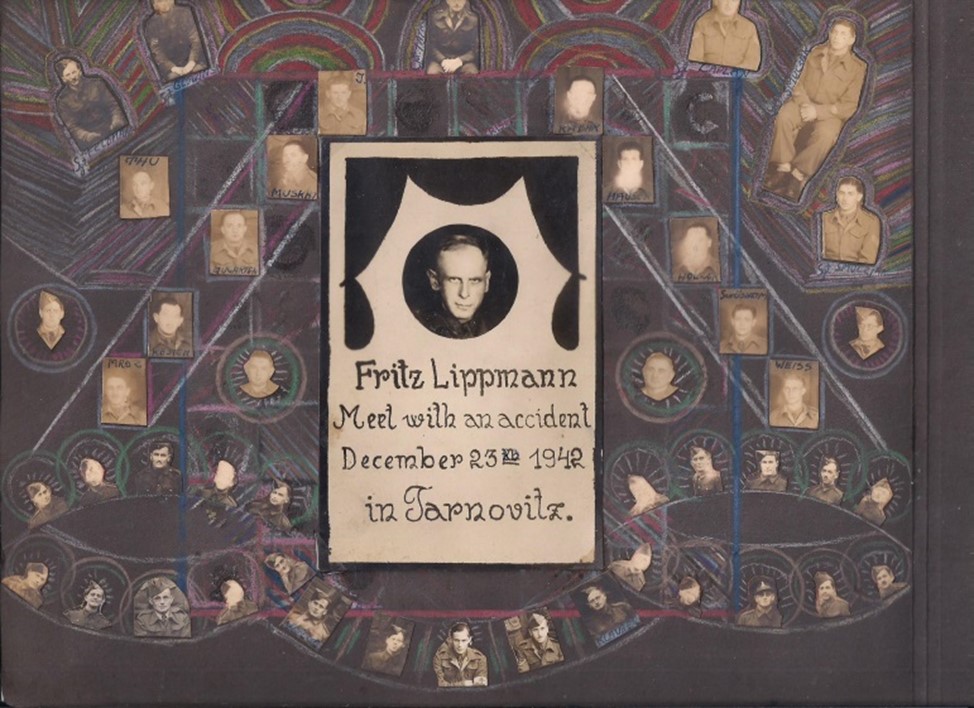
From 7 December 1942 to 19 January 1943, a period of 7 weeks, he was at camp number E479, at Tarnovitz (Tarnowskie Góry), employed in loading and unloading rail wagons. Photos from Jacob's wartime photograph album bear witness to the death of a comrade, Fritz (Peretz) Lippmann, who was hit by a train whilst working in the Tarnovitz railyard on 22 December 1942.
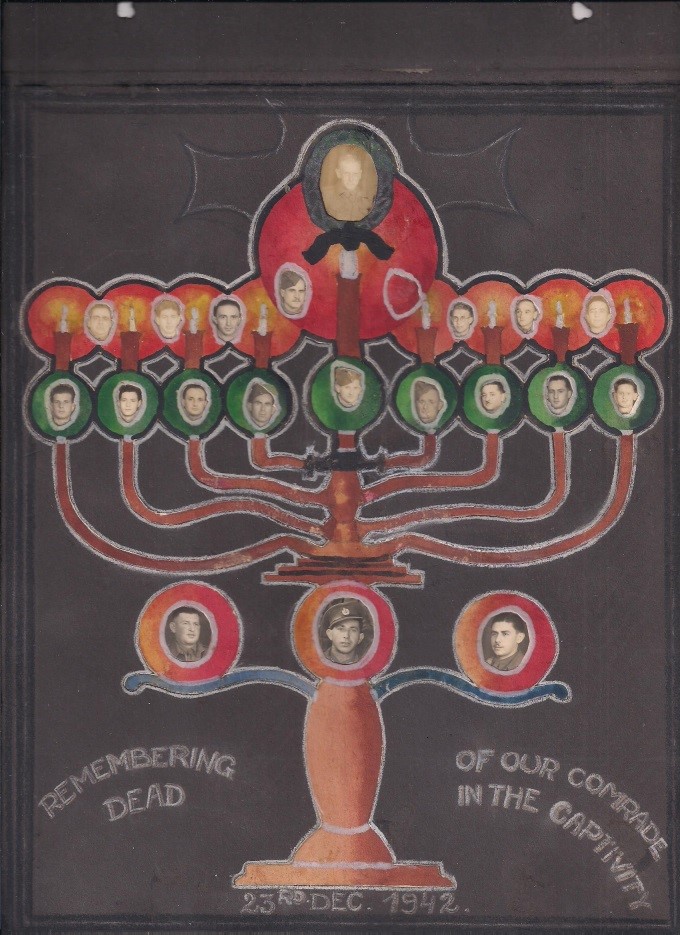 Memorial page for all who died in captivity
Memorial page for all who died in captivityFrom the photos it appears that Lippmann was buried with full military honors, with German soldiers in attendance.
Later Jacob prepared a memorial page in his album for all his comrades who had died in captivity.
20 January 1943 to 28 January 1944
During this period, Jacob's photos also place him at nearby Koschentin (modern Koszęcin), where the Lamsdorf base camp operated the E416 forced labor sub-camp, and in Jakobswalde (modern Kotlarnia), where it operated the E549 sub-camp. It was while working in the E549 camp that the Palestinian Jewish POWs came into direct contact with their co-religionists from Auschwitz, who were being worked to death in a nearby slave-labor camp. Not only did the Palestinian Jews share their food with them, but also the non-Jewish British POWs.
This was followed by 4½ months working in the Janina Coal Mine operated by IG Farben, at work camp number E562, located in Libiaz, from 20 January 1943 to 1 June 1943.
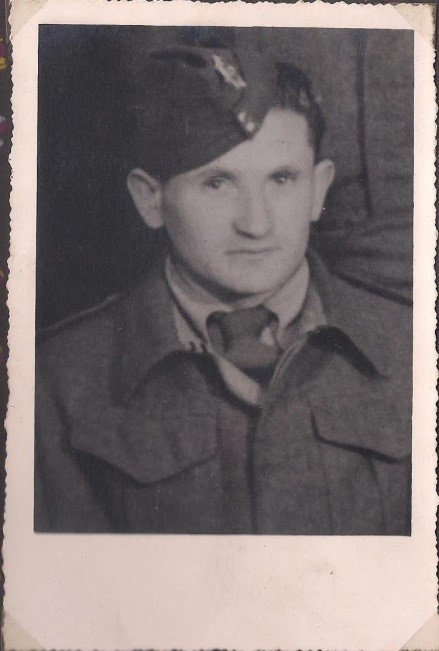
Jacob Klein 1943
Other British prisoners-of-war from Lamsdorf base camp helped to build the Nazi concentration camp at Jaworzno, which was opened on June 15, 1943, as one of the many sub-camps of Auschwitz.
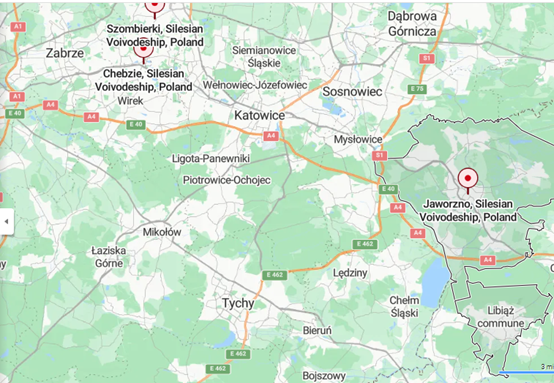
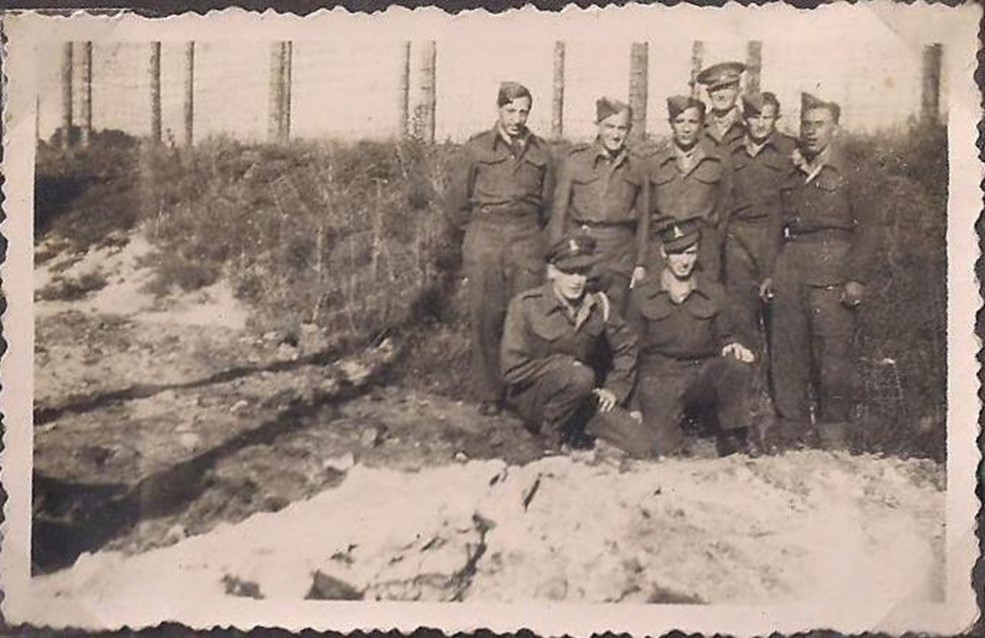 Morgenroth Jacob Klein standing second from right
Morgenroth Jacob Klein standing second from rightOn 2 June 1943 Jacob was sent by train to Morgenroth (modern Chebzie) where, between 3 June 1943 and 28 January 1944, he spent the next 8 months working in a coal mine in Schomberg (modern Szombierki), as a member of an all-Palestinian labor detachment, number E593.
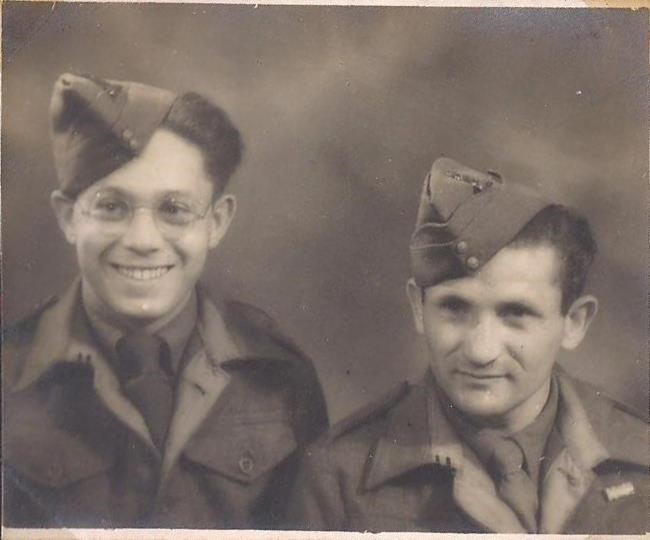
Jacob Klein right
By the end of 1943, due to overcrowding, conditions in the Lamsdorf base camp had deteriorated to such an extent, that a large number of prisoners were transferred from Lamsdorf to another camp named Teschen, and Lamsdorf's name was changed from Stalag VIII-B to Stalag 344.
In addition, the Russian advance had resulted in harsher treatment of prisoners by their German captors.
29 January 1944 to 15 January 1945
On 29 January 1944 Jacob was returned to the Lamsdorf base camp, now renamed STALAG 344, where he spent the next 2 weeks till 15 February 1944.
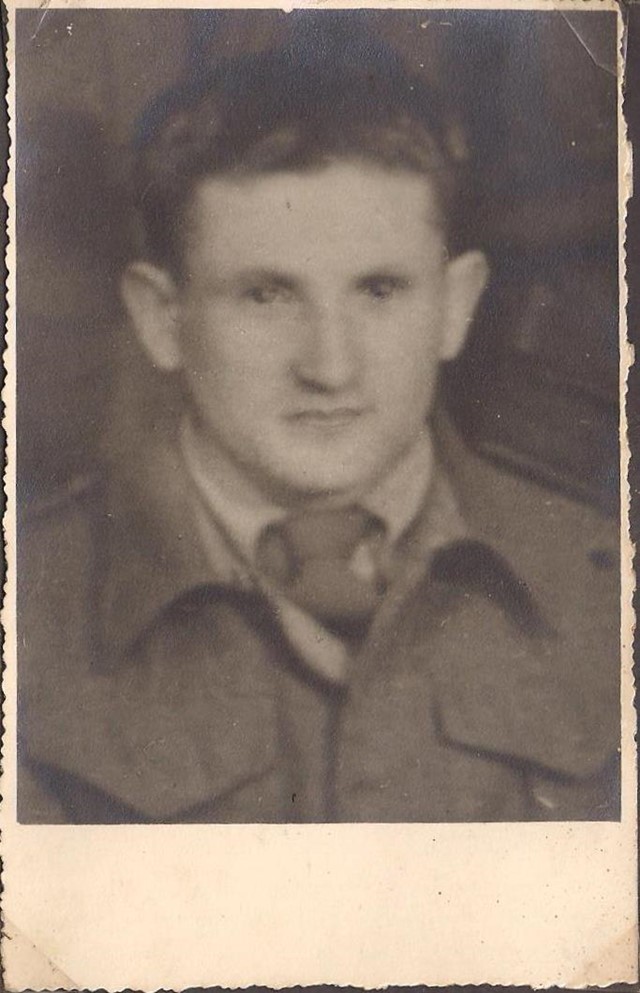
Jacob Klein 1944
On 16 February 1944 he was sent by train to work in camp number E743 at Schwientochlowitz (modern Świętochłowice) and Falvahütte (Bismarckhütte). In 1943, the Germans had established a forced labor sub-camp of Auschwitz named Eintrachthütte in Schwientochlowitz, Here, between 17 February 1944 and 3 May 1944, Jacob and his labor detachment spent the next 2½ months, possibly working in the nearby foundry.
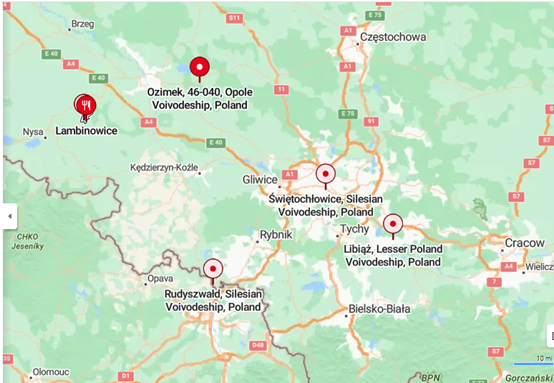
From there Jacob was transferred to camp number E747 at Ruderswald (modern Rudyszwałd), where he worked in the armaments production plant of Borsig-Werke, for 5½ weeks between 4 May 1944 and 12 June 1944.
This period concludes with a 7-month period in work camp number E775 at Malapane (modern Ozimek), from 13 June 1944 to 15 January 1945.
From Poland to Germany - The Long March
Evacuation of POW Camps and Labor Detachments Westward
By the beginning of 1945, the retreat of the Germans back into the German heartland, taking their captives with them, resulted in more and more overcrowding. In addition, the general feeling that the end was near encouraged attempts at escape.
From Lamsdorf to Gorlitz
Between 16 January 1945 and 17 January 1945, Jacob and his fellow POWs were conveyed by train to Lamsdorf. The carriages were so crowded that they had to stand all the way. This was followed by a 3-day trek on foot to the nearby base camp of STALAG 344 (formerly Stalag VIII-B), which they left on 22 January 1945, also on foot. Thus began the long march west into Germany.
The marchers started walking in a westerly direction across the Opole province of Poland, passing through Bielitzfelde (modern Bielice), Friedewalde (modern Skoroszyce) and Grabin (Grüben in German), a distance of 88 km.
Their march continued on across the province of Lower Silesia for another 119 km, through Klein Kniegnitz (modern Księginice Male), Pitschen (modern Pyszczyn), Domasław (modern Domslau) or Domanze (modern Domanice) and Alt Jauer (modern Jawor). At approximately the same time as Jacob was trudging through Alt Jauer, the town's population was being evacuated by the Germans.
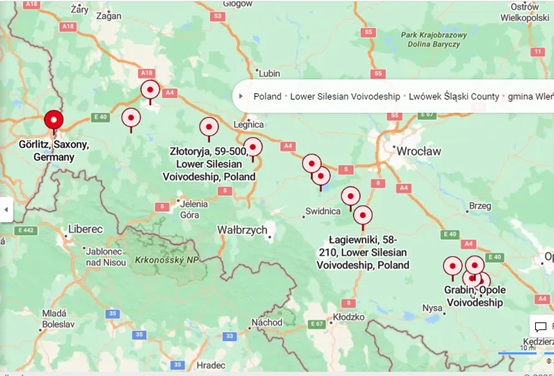
The following day they reached Goldberg (modern Złotoryja). Here, on 30 January 1945, after walking a total of 207 km in 8 days, averaging 26 km a day, they had their first day of rest. The reason why Goldberg was chosen as the first rest-stop was probably due to the fact that it was the location of two sub-camps of the Stalag VIII-A prisoner-of-war base camp at Gorlitz (modern Zgorzelec). The inmates of these two camps were mainly Poles, French and Italians. There were also two forced labor camps in the town.
They marched for another 71 km, passing through Bolesławiec, Giessmannsdorf (modern Gościszów) and Heidersdorf (modern Łagiewniki), before crossing the border into the German state of Saxony on 3 February 1945, where they spent the next five days at the Gorlitz base camp.
Bunzlau or Bolesławiec was the location of two sub-camps of the Gross-Rosen concentration camp. By this date, Soviet army units were approaching the town. A week after Jacob and his fellow prisoners passed through the town, on 11 February 1945, prisoners from both camps who were able to walk were evacuated by the Germans in a death march to the Mittelbau-Dora concentration camp in Thuringia.
Görlitz, the easternmost town in Germany, lies on the banks of the Lusatian Neisse River. On the opposite bank lies the Polish town of Zgorzelec, which was the eastern part of Görlitz until 1945. During World War II, Zgorzelec was the location of the Stalag VIII-A prisoner-of-war base camp for Allied soldiers of various nationalities. Numerous sub-camps were also located in the town, in which over 10,000 prisoners-of-war worked as forced labor in 1942, including two sub-camps of the Gross-Rosen concentration camp and seven forced labor sub-camps of the town's Nazi prison.
Near the end of World War II German troops destroyed all bridges crossing the Lusatian Neisse River to slow down the advance of the Red Army.
From Gorlitz to Zeigenhain
Jacob's march continued on across Saxony, passing through Reichenbach, Maltitz (modern Malećicy), Bautzen or Budyšin, Kamenz, Königsbrück, Kalkreuth, Meissen and Lommatzsch, where, on 18 February 1945, they had a second day of rest, after marching 170 km in 8 days.
Bautzen was the location of the AL Bautzen sub-camp of the Groß-Rosen concentration camp. At least 600 men, mostly Poles, but also other nationalities, were imprisoned there, of whom about 310 died. In April 1945, a fierce battle would be fought in the town (the Battle of Bautzen), one of the last battles of the Eastern Front during World War II, in which Polish and Russian forces fought the German army in the streets.
During World War II, from 1944 to 1945, a sub-camp of Gross-Rosen concentration camp was located in Kamenz, where forced laborers worked for a Daimler-Benz aircraft engine factory, while Meissen was the location of a sub-camp of Flossenbürg concentration camp.
Lommatzsch, where Jacob and his fellow-prisoners were allowed a day's rest, is a good example of the fluid nature of the battle front at this time. After Jacob's group had passed through in February, in April first the town was occupied by Soviet soldiers, then, the same month, it was re-occupied by German soldiers. After Berlin fell to the Red Army on 2 May 1945, more Soviet troops became available to retake the town, an event viewed by the local population as a calamity.
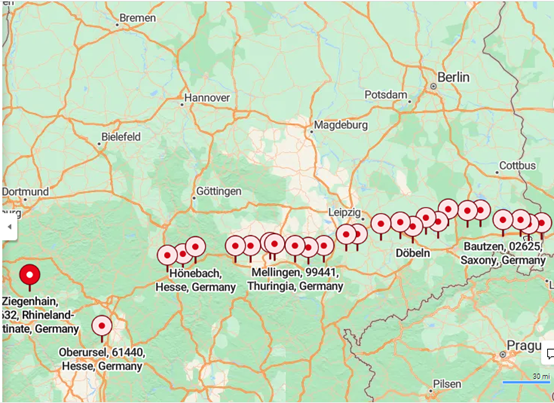
From there the march continued though Döbeln, Leisnig, Bad Lausick and Borno, a 4-day march over a distance of 77 km, before the marchers finally arrived in the State of Thuringia. There was a Wehrmacht hospital at Bad Lausick, which spared the town from aerial attacks and consequent destruction.
After passing through Meuselwitz, Zeitz and Serba, an 80 km march taking 3-days, on 26 February 1945 the marchers stopped for a third day of rest.
In 1937/1938 the industrial cartel firm of Brabag built a hydrogenation plant northeast of Zeitz, in order to produce synthetic fuels using coal liquefaction. The nearby Wille sub-camps of the Buchenwald concentration camp, located in Tröglitz, Rehmsdorf and Gleina, provided forced labor for the plant.
The next towns and villages through which Jacob and his fellow-prisoners passed were Jena, Altstadt, Mellingen, Büßleben and Seibleben. This route was 100 km long and it took them 5 days. Here, on 4 March 1945, they stopped for a fourth day of rest.
During WWII, the Germans operated two sub-camps of the Buchenwald concentration camp in the city in Jena, together with a sub-camp of the prison in Sieradz in German-occupied Poland.
Over the next couple of days they walked 40 km through Mechterstädt and Stadtfeld, before ending up in the State of Hesse. There was no significant destruction in Mechterstädt during WWII, while Stadtfeld was more adversely affected.
Walking another 22 km, they continued on to Oberursel (Taunus), where, on 8 March 1945, they stopped for a fifth day of rest, having covered 62 km in 3 days. Oberursel (Taunus) was the location of the Luftwaffe Transit Camp, where all allied airmen who were shot down and captured, were processed before being transferred to their permanent camps.
The last part of the march took them another 84 km in 4 days, through Hönebach, Sorga and Frielingen, before they arrived at their final destination - STALAG IXA Ziegenhain (modern Schwalmstadt-Trutzhain) - on 12 March 1945.
Thus ended a 2-month forced march into the heart of Germany, from 16 January 1945 to 12 March 1945, covering a distance of 867 km.
There is an account of the same march by Allan Hurrell, a pilot who was shot down and became a prisoner of war - see references below.
From Germany to the UK - Liberation and Demobilisation
Special Commander Fritz Taeuber, the Commander of Ziegenhain base camp, had been ordered to hand over his Stalag to the US Army. This he did when troops from the American Army arrived at the camp on 30 March 1945.
Jacob and his fellow Palestinian POWs were liberated. He had been a prisoner-of-war since 29 April 1941, when he was taken captive in Kalamata, Greece, a period of almost 4 years.
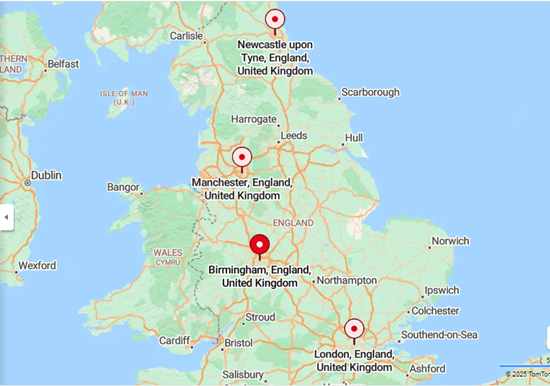
Just over a week later, on 9 April 1945, he was flown by Bomber Command to England, leaving Germany at 19.00 hours and arriving at 20.30 hours in the evening. This was probably the first time that Jacob had ever flown in an airplane.
After his arrival in England, Jacob was stationed in a transit or transfer camp near Newcastle-on-Tyne, possibly named Cole Hall. Here he remained several months, apart from visits to London for a week, between 25 April 1945 and 2 May 1945, and again for 3 days between 29 July 1945 and 31 July 1945, Manchester for 3 days between 25 July 1945 and 28 July 1945, and Birmingham for 2 days between 15 September 1945 and 17 September 1945.
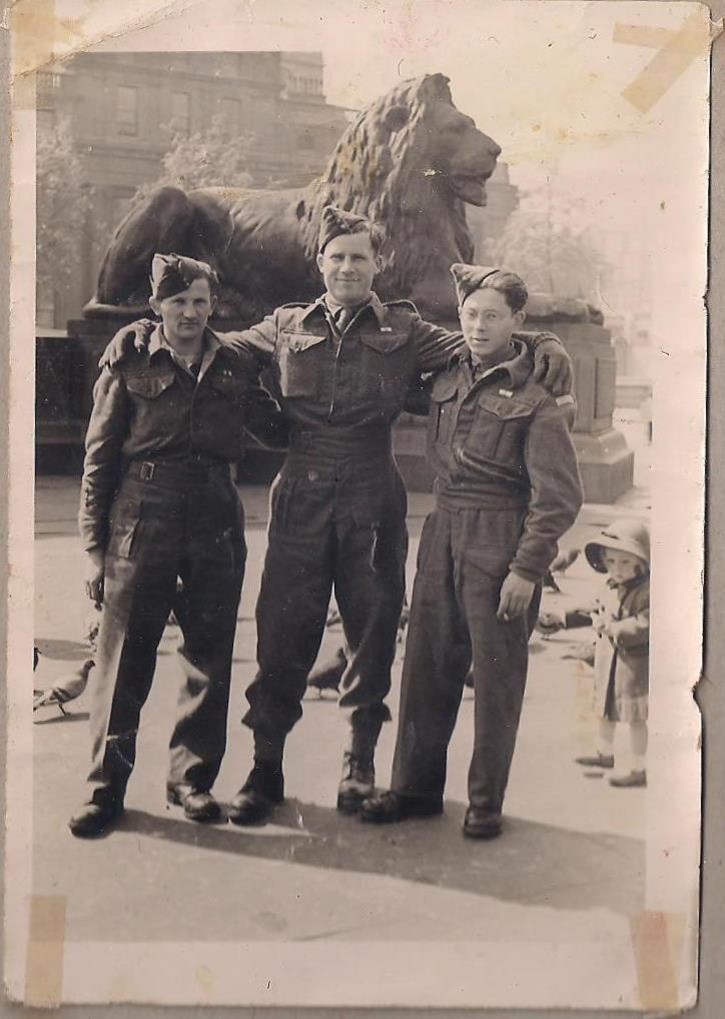
London: Jacob Klein on the left
There is no mention of his marriage on 14 October 1945 to Minnie Grossman in Birmingham.
Finally, on 20 October 1945 he travelled to Liverpool where he boarded a ship to Palestine, arriving in Tel Aviv on 5 November 1945, the voyage having taken a little over two weeks.
Both Yoav Gelber, author of “Palestinan POWs in German Captivity” and Susanne Barth, author of "The ‘Visible’ and the ‘Invisible’ Jews" agree that a number of factors contributed to the survival of Jacob Klein and his fellow Palestinian prisoners-of-war. Perhaps the most important was German acceptance of the principle of equal treatment for all British Army POWs, including the Palestinians.
The reason for Germany's acceptance of this principle was simple. The British Government insisted that Jewish POWs serving in the British army be treated the same as non-Jewish POWs, otherwise German POWs in British hands would suffer. In general non-Jewish British POWs did not keep themselves apart from the Palestinian Jewish POWs (as did the French from the Algerians).
In her comparative study on the treatment of Palestinian Jewish POWs, Jewish convicts, and Jewish inmates of the Forced Labour Camp for Jews in Blechhammer, a sub-camp of Auschwitz, between the years 1941–1945, Barth highlights the two groups out of the three that remained largely ‘invisible’ within the Nazi camp system, a fact that improved the chances of their survival. 'Invisible' in this context means that they wore no external marking of their Jewishness, and that the German authorities chose to ignore the fact they were Jews, thus keeping their Jewish identities largely secret. As a result their survival rates were considerably higher than those of the third group – the Jewish civilian inmates of Blechhammer.
The Palestinian POWs started off as a very heterogeneous group; almost the only thing uniting them was the fact that they were Jewish. At the end of four years in captivity, this was definitely not the case. Their shared experience and suffering had united them into a people.
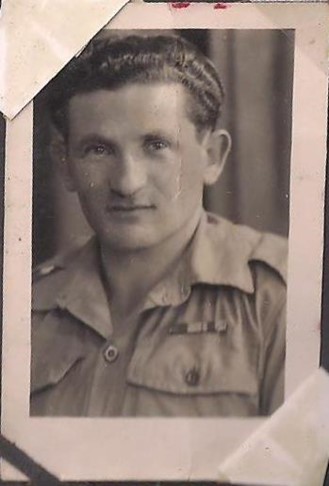
Jacob Klein 1945
After marrying his British-born Jewish wife, Minnie Grossman in Birmingham on 14 October 1945, Jacob Klein returned to Palestine where he was registered as an immigrant on 30 December 1945. After his wife joined him in Palestine, registering as an immigrant in Kantara on 15 May 1946, their first child, a daughter, was born on 31 Jan 1947. The whole family applied for a Certificate of Naturalisation, which was granted them on 5 March 1948. At this time they were considered Palestinians. Only after the State of Israel was created in May 1948 did they become citizens of Israel.
References
This account is based on Jacob Klein's record of dates and place names written on an unknown date.
The wartime experiences of Jacob Klein have been placed in historical context by reference to the sources mentioned below. For convenience and permanency these have been extracted as pdf files and can be downloaded from here.
Prisoners of Memory by Yoav Gelber (pdf file)
This is the most important research on the captives' story by Professor Yoav Gelber, a historian at Haifa University. Gelber based his study on numerous documents collected in Israel and abroad, and on interviews with former members of the British army. In 1982, as the work was progressing, he wrote an article about the subject for Yad Vashem titled "Palestinian POWs in German captivity".
Palestinian POWs In German Captivity by Yoav Gelber (pdf file)
This is "Palestinian POWs In German Captivity", Yad Vashem Studies, Vol. XIV, Yad Vashem, Jerusalem, 1981 pp. 89-137.
Palestinian Prisoners of War (pdf file)
“The ‘Visible’ and the ‘Invisible’ Jews: A Comparative View on the Treatment of Palestinian Prisoners of War, Jewish Penitentiary Prisoners, and Inmates of the Forced Labour Camp for Jews Auschwitz Sub-Camp in Blechhammer, 1941–1945”. Susanne Barth
2017. S: I.M.O.N. Shoah: Intervention. Methods. Documentation. 4 (2): 59-68.
The Long March by Allan Hurrell (pdf file)
A Rhodesian RAF pilot named Allan Hurrell who had been shot down near Stavanger, Norway in May 1942, spent several months recuperating in a hospital in Norway, and was then transferred to the Lamsdorf base camp. After an unsuccessful escape attempt, he took part in the Long march from Lamsdorf base camp in Poland to Ziegenhain base camp in Germany, describing it as "a well documented forced march, lasting 50 days and covering 175 miles." It follows the same itinerary and dates of Jacob Klein's record.
The account is available through the courtesy of the BBC archives (search for "WW2 People's War Allan Hurrell"). The archives are of wartime memories contributed by members of the public and gathered by the BBC.
And thanks to Wikipedia

The Musketeers from the point of view of Israel Tillinger
View Israel Tillinger's profile (opens in new window).
Unfortunately we possess no information about Israel Tillinger's wartime experiences.

